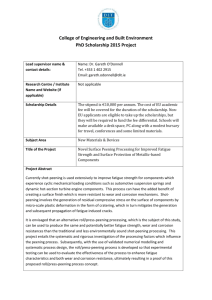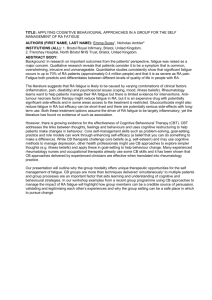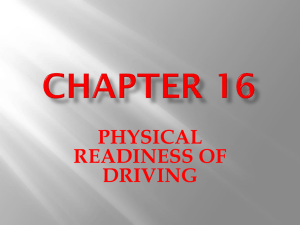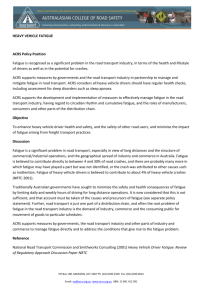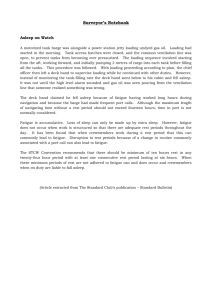Safety alert - Heavy vehicle driver fatigue (micro-sleep)
advertisement
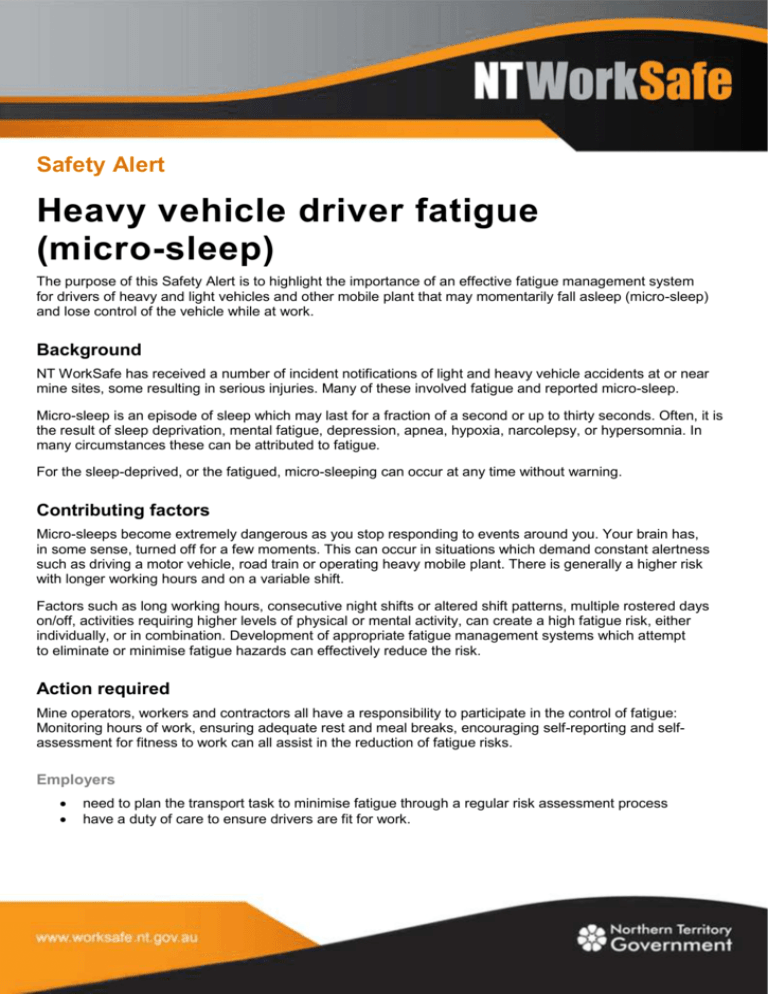
Safety Alert Heavy vehicle driver fatigue (micro-sleep) The purpose of this Safety Alert is to highlight the importance of an effective fatigue management system for drivers of heavy and light vehicles and other mobile plant that may momentarily fall asleep (micro-sleep) and lose control of the vehicle while at work. Background NT WorkSafe has received a number of incident notifications of light and heavy vehicle accidents at or near mine sites, some resulting in serious injuries. Many of these involved fatigue and reported micro-sleep. Micro-sleep is an episode of sleep which may last for a fraction of a second or up to thirty seconds. Often, it is the result of sleep deprivation, mental fatigue, depression, apnea, hypoxia, narcolepsy, or hypersomnia. In many circumstances these can be attributed to fatigue. For the sleep-deprived, or the fatigued, micro-sleeping can occur at any time without warning. Contributing factors Micro-sleeps become extremely dangerous as you stop responding to events around you. Your brain has, in some sense, turned off for a few moments. This can occur in situations which demand constant alertness such as driving a motor vehicle, road train or operating heavy mobile plant. There is generally a higher risk with longer working hours and on a variable shift. Factors such as long working hours, consecutive night shifts or altered shift patterns, multiple rostered days on/off, activities requiring higher levels of physical or mental activity, can create a high fatigue risk, either individually, or in combination. Development of appropriate fatigue management systems which attempt to eliminate or minimise fatigue hazards can effectively reduce the risk. Action required Mine operators, workers and contractors all have a responsibility to participate in the control of fatigue: Monitoring hours of work, ensuring adequate rest and meal breaks, encouraging self-reporting and selfassessment for fitness to work can all assist in the reduction of fatigue risks. Employers need to plan the transport task to minimise fatigue through a regular risk assessment process have a duty of care to ensure drivers are fit for work. Drivers need to follow fatigue management and trip procedures that have been designed to reduce safety risks associated with fatigue being fit for work at the start of a shift and during a shift is a major contribution that you can make towards a safe environment manage your time between shifts and your lifestyle in a responsible way in an effort to prevent fatigue. It is your obligation. Further information Legislation NT Workplace Health and Safety Act Section 55 Employer’s general duty of care NT Workplace Health and Safety Regulation 152 D fitness to work program The fitness to work program must specify appropriate risk management measures to minimise, as far as reasonably practicable, the risks resulting from fatigue. 38 (1) Hazard identification and risk assessment An employer shall ensure that appropriate measures are undertaken to identify all hazards from work which may affect the health and safety of a worker and any other person who could be affected by the work. Websites NT Road Transport Code of Practice National Transport Commission Guidelines for Managing Heavy Vehicle Driver Fatigue National Transport Commission Australia Department of Lands and Planning Motor Vehicle Registry Information Bulletin V70 Heavy Vehicle Driver Fatigue Contact details Call us on: 1800 019 115 Email us at ntworksafe@nt.gov.au For more information on work health and safety, go to the NT WorkSafe website at www.worksafe.nt.gov.au Disclaimer This Safety Alert contains safety information following inquires made by NT WorkSafe about an incident or unsafe practice. The information contained in this Alert does not necessarily include the outcome of NT WorkSafe’s action with respect to an incident. NT WorkSafe does not warrant the information in this Alert is complete or up-to-date and does not accept any liability for the information in this report or as to its use. 2 Heavy vehicle driver fatigue (micro-sleep) (version 1.0 – 2 September 2011)

